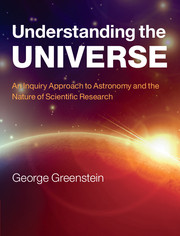Book contents
- Frontmatter
- Contents
- Preface
- Acknowledgments
- Part I Introducing steps to astronomy
- Part II The Solar System
- 6 Introducing the Solar System
- 7 The inner Solar System
- 8 The outer Solar System
- 9 Smaller bodies in the Solar System
- 10 Planets beyond the Solar System
- Part III Introducing stars
- Part IV Introducing galaxies and the Universe
- Epilog
- Appendix I The small-angle formula
- Appendix II Exponential notation
- Appendix III The Solar System
- Appendix IV The closest and brightest stars
- Appendix V Physical and astronomical constants
- Appendix VI Conversion factors
- Appendix VII Constellation maps
- Glossary
- Figure Credits
- Index
- Plate section
7 - The inner Solar System
from Part II - The Solar System
Published online by Cambridge University Press: 05 February 2013
- Frontmatter
- Contents
- Preface
- Acknowledgments
- Part I Introducing steps to astronomy
- Part II The Solar System
- 6 Introducing the Solar System
- 7 The inner Solar System
- 8 The outer Solar System
- 9 Smaller bodies in the Solar System
- 10 Planets beyond the Solar System
- Part III Introducing stars
- Part IV Introducing galaxies and the Universe
- Epilog
- Appendix I The small-angle formula
- Appendix II Exponential notation
- Appendix III The Solar System
- Appendix IV The closest and brightest stars
- Appendix V Physical and astronomical constants
- Appendix VI Conversion factors
- Appendix VII Constellation maps
- Glossary
- Figure Credits
- Index
- Plate section
Summary
We now turn to a more detailed tour of the Solar System.
In this chapter we will visit our Moon, and then tour those planets lying closest to the Sun. Our own home world is one of them: the others are Mercury, Venus and Mars. These planets constitute what might be called our immediate vicinity, the portions of the Solar System that lie closest to us. But the real reason to treat all these bodies at once is that, taken together, they constitute the inner Solar System, all of whose planets are relatively small and dense and are composed of rock. In the next chapter we will encounter the outer planets, which are entirely different: far larger, and composed primarily of gas.
The farther out we will look, the more alien will the worlds become: in this chapter we’ll start with something more or less familiar. But even these, our nearest-neighbor worlds, will turn out to be full of surprises. And perhaps this is the most important lesson of all: the Universe continually surprises us, and it is endlessly fascinating.
The Moon
Observing the Moon
The first stop on our journey will be our own Moon (Figure 7.1). To the naked eye the Moon consists of light areas and irregular dark splotches. These dark regions were termed maria (“MAH-ria”) by the ancients, from the Latin mare (“MAH-ray”) for “sea.” Although we now know they are ancient lava flows, not oceans, the name has stuck. The view through even a small telescope or pair of binoculars is far richer. In lighter areas can be seen mountains together with innumerable craters, from the largest of which great white rays are seen to emanate. The maria too have craters, though far fewer of them.
Information
- Type
- Chapter
- Information
- Understanding the UniverseAn Inquiry Approach to Astronomy and the Nature of Scientific Research, pp. 174 - 213Publisher: Cambridge University PressPrint publication year: 2013
